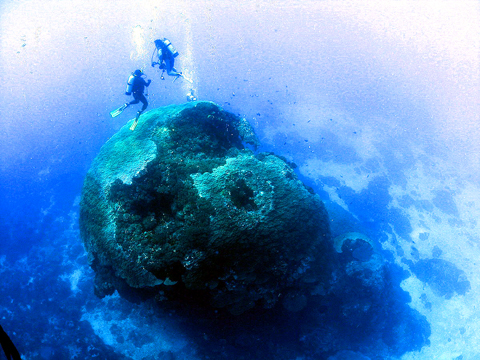I thought i’d post this this spectacular image from an article from the Taipei Times quoting Dr Allen Chen on the recent increases in sponge overgrowth affecting reefs off the coast of Taiwan. The photograph appears to be a massive coral (Porites spp), affected by what the researchers are calling the “black plague“. For perspective compare the size of the two divers with the coral beneath them – these massive creature are the behemoths of the oceans, with a single colonies recorded over 7m in width. The largest of these corals are estimated to be up to 700 years old, often recording numerous environmental events such as floods, temperature and even oil spills.
Climate Shifts
Life in a rapidly changing climate


Hi, Ove. many thanks for posting this news in ClimateShift. Yes, this Porites Lobata is a giant coral. Dr. Keryea Soong and I published a ReefSite, in Coral Reefs in 1999 to describe this very large Poritid in the Green Island. Please refer this paper if you are interested in reading it. This colony, the top of which is about 8 m from the water surface, has a circumference of 31 m at a depth of 12 m, and sits on a sandy bottom at about 20 m in depth. We have no idea to what depth the base is (covered by sand). We estimated this giant Porites is over 1000 years old. It has a nickname, “Big Mushroom”, by local divers, since it looks like a Chinese black mushroom from the side view. This coral colony is definitely a landmark to the Green Island and deserved the priority of conservation. I and a group of local divers are trying to promote conservation of Big Mushroom in the Green Island. We just finished the ReefCheck of Green Island last weekend.
However, there is a small mistake by the news paper that I would like to correct . First, I did not get the direct interview by the reporter of Taipei Times. Second, after I read this report, I realised it is from the translation of a local Mandarin newspaper. Therefore, the content in the Taipei Times is about a cyanobacteriospnge infection (black plague quoted in the newspaper) on reef-building corals in the Green Island, nothing to do with this porities coral. We have a research team studying this cyanobacteriosponge outbreak right now. However, this outbreak is restricted to the shallow water reefs in the Green Island. According to our survey, this giant Porites does not have the infection of cyanobacteriosponge. Therefore, black image you saw from this picture is not the “black plagues” but the Xenia softcorals and sponges. I think this reporter placed a wrong image in the newspaper. So, cause the confusion. Indeed, I did speak to the Mandarin reporter about the conservation issue of Giant Porites in the local newspaper. The two big holes you saw from this picture was probably the damages caused by the submarine’s occasional bumping into the colony 10 years ago. Although the submarine is no more operated in the Green Island, the two big holes have been overgrown by other benthic organisms, such as softcorals, sponges, etc. This is one of the threats to the survival of this colony. Other impacts such as bleaching also threat its survival .
Nevertheless, It is very interesting to just dive around and see this Big Mushroom. The water is clear and visibility is so high in the Green Island.